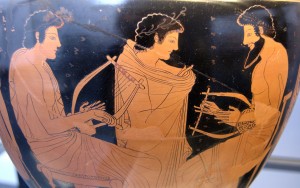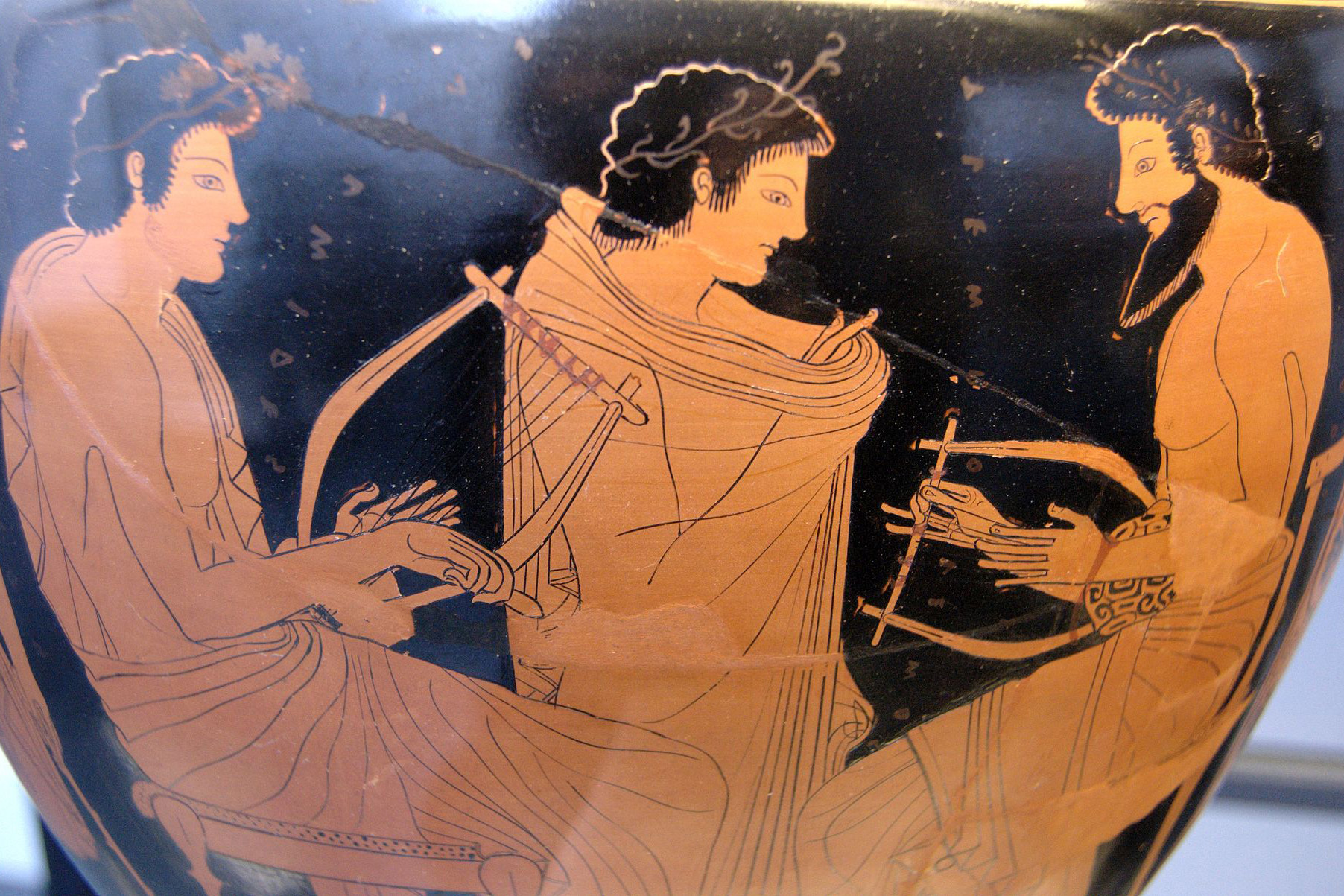 The video below, which was featured on NewAdvent.org yesterday shows a remarkable relationship and unity between two things we seldom think of together: sound and geometry. And yet, there it is.
The video below, which was featured on NewAdvent.org yesterday shows a remarkable relationship and unity between two things we seldom think of together: sound and geometry. And yet, there it is.
From my own studies I have long seen a kind of relationship between music and math. For example, the current 12-Tone scale was developed in the 15th Century using the Pythagorean theorem. Clearly music and geometry come together since the length of a string or a pipe determines the pitch of the sound made. Thus, geometry and sound DO relate.
More artistically I have always relished the mathematical precision of Baroque music, especially of the Bach fugue, which amounts to a kind of mathematical progression on a musical theme.
But all my linking of math and music was something I thought of as largely a manner of thinking, an intellectual connection if you will. But the video below shows that there more than intellectual abstraction going on. The connection between sound and geometry is also physical. As each tone is produced, the geometry is produced and visible to the eye. As the tone changes, so does the picture created.
Frankly: Wowza! It is a wonder and awe moment!
And why shouldn’t there be a clear relationship? At the end of the day, all things are one, and connected because the one God who is simple and and one, produced them all. We see his fingerprints in everything he has made. In the video, God’s fingerprints are beautifully displayed.
Most people don’t connect sound and geometry. But since they both come from God, they are connected, and it merely falls to us to discover the relationship.
For years now scientists have sought to find a unifying and simple theory that explains everything. Some decades ago it was called the “Grand-unified Theory.” More recently the media coined the term “God-particle.” Whatever you want to call is, the hunt is one for the one thing that explains everything.
Theologians have known the answer for thousands of years, and expressed it in our own terms. The grand unified theory, the one thing that explains everything is Love. God is love, and He who IS love explains everything. Why is there something as opposed to nothing? Love. Why is the universe so big and so diverse, why such extravagance? Love. Why is there justice, why is there beauty, why is there order, why is there desire? Love!
Love is not merely something God does, it is not a mere attribute. God IS love. And as love, he has done all things. Love explains everything. God is Love and Love loves, that’s what love does, it loves. Why are sound and geometry ultimately one? Because the same Love made them both and resonates in them both. The same Love sustains them.
Do not misinterpret this. Distinctions are important, at least for us humans. We need to distinguish and must distinguish. It is the basis of thought for us, who are contingent and limited beings. But at the end of the day, what we distinguish as more in common that it has in distinction. Why? Because God who is Love made and sustains everything. We ought never forget, as we distinguish, (for we must), that there is a deeper and mystical union to all things.
Perhaps I can end with a “Desert Father” story which I do not recall as to its origin, but I recite it from memory:
One day, a disciple came to the Abbot and asked, “What am I to do about the distance I experience with God?” The Abbot replied, “Understand that it isn’t there.” “Does that mean that God and I are one?” said the monk? Father Abbot said, “No one….not two.” “How can that be?” said the perplexed monk. The Abbot looked at him and said, “The ocean and its wave, the singer and his song, the candle flame and its light…..not one, not two.”
And the point is that all our little categories and distinctions fall short as we draw near to God. Even the simply defined 2 versus 1. As humans, in our experience we must distinguish. For as limited beings we can only see pieces at a time. But our distinctions are ultimately a sort of analogy. Things also have a unity we cannot deny. Why? God is love, and Love made and infuses all things.
A chair, a monkey, a water molecule, sound, light, and geometry, ultimately have more in common than they have apart. Distinctions for us are a kind of necessary evil. But we ought remember, at the end of the day, that Christ hold all creation together in himself. And that at the end, there will be, in the words of St. Augustine: Unus Christus, amans seipsum. (One Christ, loving himself).
This is not pantheism. For God transcends all he has made. He is bigger than all this. But he unites all this. The Grand unified theory is simply this: God is love. Love is the answer to the ultimate why and how of all things.
Now the video. Behold the fingerprints of God’s love.


“like” the Golden Ratio
Wonderful Monsignor, how do you access all these tremendous videos that serve beautifully as instruments of instruction?
Thank you.
Wonderful thoughts, wonderfully presented. It is in the Incarnation that God transcends his own transcendence. St. John said in his first letter: “When anyone acknowledges that Jesus is the Son of God, God dwells in him and he in God” (1 Jn 15). St. Columban adds: “It is no God dwelling far off from us that we seek, whom if we merit it we have within us. For he resides in us like soul in body, if only we are sound members of him, if we are not dead in sins, if we are uninfected by the taint of a corrupt will; then truly does he reside in us who said, ‘And I will reside in them and walk in their midst.’”
God is amazing!! The more we learn about just how precise and orderly God is, the more we can trust Him with the details of our lives!
One thing that is neat about movie music is that there is some movie music that fits perfectly with a movie that in general people wouldn’t listen to separately from the movie. Horror movies are the best example of this. The soundtrack to the movie Psycho is widely celebrated, but I know of no one who has or wants to listen to the soundtrack separately from the movie.
This is my best recollection of the Myth of Pythagoras: he came upon four blacksmiths and was amazed that their hammering was somewhat consonant. Upon, examination, he realized that one hammer was never consonant with the other three hammers and discarded it. The remaining three hammer were each always consonant in pairs and as a group. The hammers weighed two pounds, three pounds, and four pounds. 2:4 or 1:2 is the ratio of the octave. 2:3 is the ration of the perfect fifth. 3:4 is the ratio of the perfect fourth. Thus began the understanding that the notes of the scale could be represented by whole number ratios.
So you want to write a fugue? Glenn Gould – 29. Glenn Gould, So You Want To Write A Fugue ? [ 1963 ] https://www.youtube.com/watch?v=_G9LMbP6zTM
Thank you, Amen.
This is a great subject and opens up to the whole possibility of demonstrating in some way, objective beauty.
I have tried discussing this with friends but have been amazed at how difficult it is for most people to make a distinction between objective beauty and personal tastes. They tend to deny that there is any objective beauty at all, especially when it comes to music.
I think that what the ancient philosophers used to call the study of music is what we today call mathematics if I’m not mistaken.
Also I remember hearing that in some liberal arts colleges (Saint Thomas Aquinas college) they teach all their students how to compose their own symphonies by using the mathematical principals involved in music.
How objective is that?
I think that the measure of a persons like or dislike of objective beauty is more of an indication of the state of their soul than that there is no such thing as objective beauty.
I think people are afraid that if they admit that something is better than something els that they will have that thing forced on them. It seems they prefer to enjoy what ever coincides with their passions and don’t want to admit that their passions could at times be disordered.
Have you ever noticed how defensive some people get when you try to discus honestly about this subject?
“… the length of a string or a pipe determines the pitch of the sound made.” There’s that and more. The ratio between the length and the diameter (thickness?) of a string or pipe relates to the sound. Different ratio, different sound.
This thought leads me to consider your comments, further on, “The grand unified theory, the one thing that explains everything is Love. … ” “For as limited beings we can only see pieces at a time.”
The pieces of a jigsaw puzzle are many but, in the end, there is one finished and complete puzzle.
How often and often I’ve heard someone mention a fact about something that is imperfectly understood. Then, someone else mentions another fact and the two discoverers (and, sometimes, their supporters) argue endlessly about which one is the right fact when, in reality, each is a part of a greater whole.
Beautiful insight, Charles. Absolutely beautiful.
It is this sort of unity, between beauty and truth, music and math, art and science, that can unite different groups of people.
Like you Catholics and us non-Catholics.